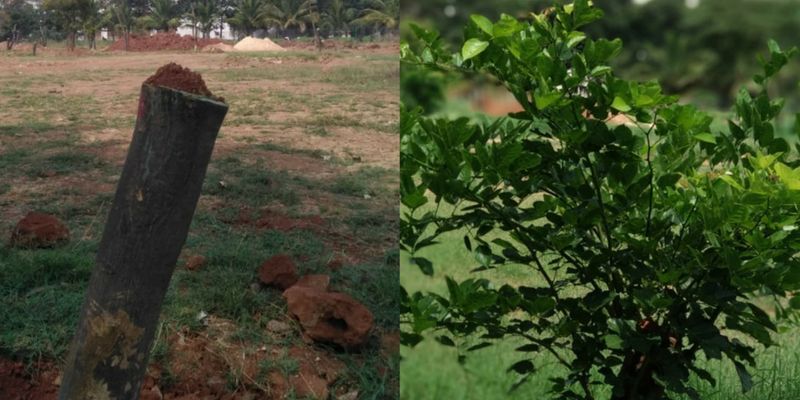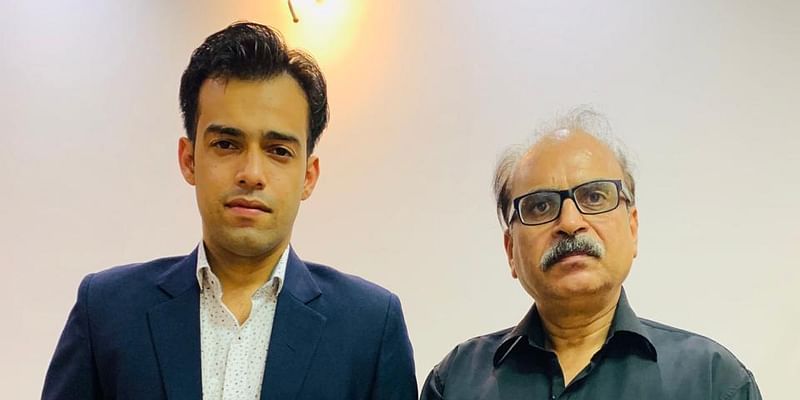108 trees transplanted with 100 pc success – Bengaluru is proud of this citizen initiative
When Namma Metro wanted to pull down 108 trees in Whitefield, Bengaluru for the construction of a new metro line, a group of inspired citizens and a super speciality hospital came together to transplant them and achieved 100 percent success! How did they do it? Can we replicate this?
“I have transplanted trees before in different areas of Bengaluru like Sarjapura and Kanakpura, but this was something exceptionally phenomenal!” says Vijay Nishant, a much-sought-after urban conservationist, popularly known as the ‘Tree Doctor’.
For 10 years now, he has been striving to rescue and rehabilitate trees and urban wildlife. The Government of Karnataka awarded him with the Asamanya Kannadiga Award (Extraordinary Citizen of the State) in 2017.
“To relocate 108 trees, with each of them not just surviving but thriving gloriously, and all done in a matter of six months and in a spirit of pure selflessness by a voluntary citizen group – this is unprecedented, not just in Bengaluru but perhaps the whole of India!” Vijay’s excitement was infectious.

The beginning: calling the ‘Tree Doctor’
It was August 2017. The construction of the new Metro line connecting Byappanahalli to ITPL was on. Ram Kanala, a software architect working in IBM, looked out of his office window one day and noticed that trees were being felled by the BMRCL (Bangalore Metro Rail Corporation Ltd) to make way for the Metro line.
“Bengaluru was once called the ‘Garden City of India’. Let alone gardens, even street-side trees are now not spared,” ruminated Ram.
He decided to approach the BBMP (Bruhat Bangalore Mahanagara Palike) officials to explore ways of protecting this precious green cover. Why not transplant the trees, Ram suggested.
But the BBMP officials rejected his idea outright, saying that these were big trees and will not survive such an operation.
Ram, however, was not convinced. He wanted an expert opinion on this. So he went to the Indian Institute of Science (IISc), Bengaluru, and spoke to the scientists there. They wanted more data on the size, type, and species of the trees.
Ram not only furnished them with the relevant information but also had detailed discussions with them to understand and explore the feasibility of the tree transplantation idea.
Finally, after analyzing the data, the scientists concluded that it was definitely possible, and was, in fact, worth a try. But it had to be done by an experienced “tree doctor”.
It is then that Ram connected with Vijay who was known for his ‘Tree IQ’. In 2010, Vijay had launched Vruksha.com, a first-of-its-kind biodiversity portal, to provide a detailed tree census of urban areas. It involves mapping of trees by street location and by species.
For the tree-passionate Vijay, cutting a tree was like “cutting my heart”. So he jumped at this opportunity to save these 115 trees which were about to be cut by the BMRCL.
The Vijay-Ram team decided to go all out to execute the idea. They went back to the BBMP, now armed with the scientists’ recommendation for the tree transplantation. After a series of meetings with the officials there, they finally got permission to undertake their operation.
The first hurdle was crossed, but they knew there were many more to come. It was not going to be an easy task as the trees were fully grown, and their roots, in all likelihood, had spread 10 feet underground in all directions.
However, the next big challenge was – where to transplant them to? They had to find a new shelter for these 115 ‘sturdy green soldiers’.

Finding a new home in the Sathya Sai Hospital
“I approached several top software firms in the EPIP (Export Promotion Industrial Park) area who are indeed going to benefit from the new metro line, to spare some land,” Ram recounted. “But given how expensive real estate is in Bengaluru, everyone refused, citing space constraints as an excuse.” Ram became increasingly frustrated, as he didn’t want to give up but couldn’t find a solution either.
It is at this point that one day while driving past that area, his eyes fell on the beautiful lawns of Sri Sathya Sai Institute of Higher Medical Sciences (SSSIHMS), a super speciality hospital offering high-end tertiary care to all, at no cost to the patients.
Something within told him to give it a shot here. As a last-ditch effort, with little hope, he emailed the director of this hospital with his plea. “In no time, I received a reply offering full cooperation. I was simply thrilled!” Ram remembers.
With the land-issue sorted out, the jubilant Ram now got into mission-mode, forming a cohesive team of BMRCL engineers and workers, nature enthusiasts, EPIP area administrators, SSSIHMS senior managers and garden supervisors, and green social workers. This committed team of roughly 20 people was inspired by the vision of this unique endeavour.
A few days prior to Ram’s email, senior managers of the hospital had brainstormed to increase the hospital’s green cover further. The employees of an adjacent IT company wanted to plant fruit trees in the hospital premises and the Director had welcomed them too.
A few in the hospital had even toyed with the idea of transplanting the trees being felled right in front of their building. However, since they did not have much know-how on this, it had remained just as an idea.
“It is at this point that our Director received the mail from Ram. So, everything just fell into place so beautifully,” Praveen revealed.

Sensitivity meets positivity to create remarkable results
With ITD Cem India, the contractors of BMRCL (Bangalore Metro Rail Corporation Limited) hired to construct the new metro line, enthusiastically coming forward to lend their machinery and workers for this project, the work began in earnest in December 2017. Out of the 115, six trees could be left untouched, thanks to a slight tweak in the route. The rest 108 had to move.
Tree transplanting is an elaborate process of marking, diligent digging, root-bowling, disinfecting, pruning, crane-lifting, and simultaneously new-pit preparing, soil culturing, manuring, supplementing with root formulations, protecting it with fungicides and medicines, and then replanting, watering, and finally checking for any ‘post-operative complications’ and taking quick remedial action till the ‘patient’ is stable.
“You need specialized cranes for this activity but it is difficult to find them in India,” explained Vijay. “In fact, if we had access to them we wouldn’t need to prune the trees. Sadly, we had no option here but to do away with their branches and leaves to enable the operation.”
When the first tree was uprooted, Vijay and the team were highly anxious. They did everything as per the rule book within the infrastructure constraints, and waited with bated breath to see if their ‘patient’ would come back to life after the ‘transplantation surgery’.
A couple of weeks passed. Inspecting, watering, and manuring continued. Finally, on the auspicious eve of the Sankranthi festival in January 2018 came the good news! Not only the first tree, but several others too were ‘green smiling’ with their fresh shoots and leaves. “This was absolutely thrilling! Our enthusiasm tripled,” said Vijay excitedly.
He attributed this success to the clinical precision with which the team had executed the project – and something else too.
“I must add that the ambience in this hospital is extraordinary,” Vijay stated emphatically, explaining, “In fact, until this project I had no clue that this institute provides completely free tertiary care in the form of zero-cost cardiac and neurosurgeries to anyone who comes in seeking help. The place is indeed charged with selflessness and goodness.”
“To me, what we have achieved in this hospital is nothing sort of a miracle,” he asserted. “In all my previous tree transplant endeavours, I had seen only 30-40 percent success. But here all the 108 trees sprung to life seamlessly, and in a matter of few months! Anywhere else it would take at least a year or two. The power of positivity that pervades in this hospital has to be experienced to be believed,” said Vijay, his eyes shining with a new glow.

The cascading effect of goodness
This project was so close to Ram’s heart that he personally spent over Rs 45,000 procuring chemicals, sand, red earth, and tankers to water the plants regularly. He spent long hours on weekends, supervising the transplantation. At times, he did this even during the work days and compensated for it by working late into the evenings to catch up with his official duties.
“It was a tough task, but a very fulfilling one,” Ram happily recounted. “I have some very cherished memories from this exercise. I recall one evening when we did not have adequate water for the freshly transplanted trees. Along with Nagraj, the hospital’s landscaping supervisor, I personally went in search of a tanker. It was almost 9.30 PM when we located one near Vydehi hospital. When we explained our urgency to the tanker owner, he readily agreed to provide a full tank free-of-cost.”
The project indeed witnessed many such stories of cascading compassion. The alumni from the 1996 batch of Sri Sathya Sai Institute of Higher Learning, to quote another beautiful instance, voluntarily collected resources to take care of the entire expenditure of this project.
A moral boost to the whole activity was the Director of the hospital himself visiting the site frequently to check the health of his ‘new patients’. Soon the ‘green word’ went around and keen environmentalists and green social workers too dropped in and kept the inspiration-engine running.

The Tree Doctor’s new ST-UT-PT formula
On May 26, 2018, SSSIHMS organized a special function christened as “Green Century” to celebrate the project’s completion as well as to felicitate every participant of this unique endeavour. Noted Kannada filmmaker, actor, and director Suresh Heblikar, who is also a well-known environmentalist, was present to grace the occasion.
So now that the work is successfully accomplished, how does Vijay feel?
“Professionally, yes, it was a great achievement for me, and I will be lucky if I can replicate this elsewhere. More importantly, it has given me a formula for success for all my future sustainable development initiatives. I would like to call this the ST-UT-PT formula.
ST – Sensitivity towards our Trees – we have to feel for our green neighbours!
UT – Unity of Energies – inspired people have to come together, then incredible things can happen!
PT – Power of Positivity – when you work with selfless minds and institutions, success and satisfaction is guaranteed!
“Truly, I feel humbled to be part of this noble work. I connected with so many good people whose motto in life is to only serve without any expectation. This indeed has been my life’s most heartwarming work to date,” Vijay signed off with a satisfactory smile.
The way forward
One of the most debated topics in the current times, when it comes to nature conservation, is ‘How can we do development if we don’t want to lose our green cover?’ Perhaps, Vijay, Ram and the Sai Hospital have demonstrated one beautiful way.
In fact, inspired by this experience, now BBMP and BMRCL have started proactively transplanting trees which are on the new Metro rail routes. That’s the way to go, Bengaluru!











![[The Turning Point] Why pay brokerage? The idea that led to real estate startup NoBroker](https://images.yourstory.com/cs/2/730b50702d6c11e9aa979329348d4c3e/NoBroker-1587120686615.png)